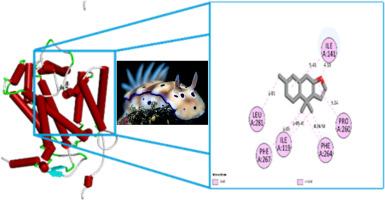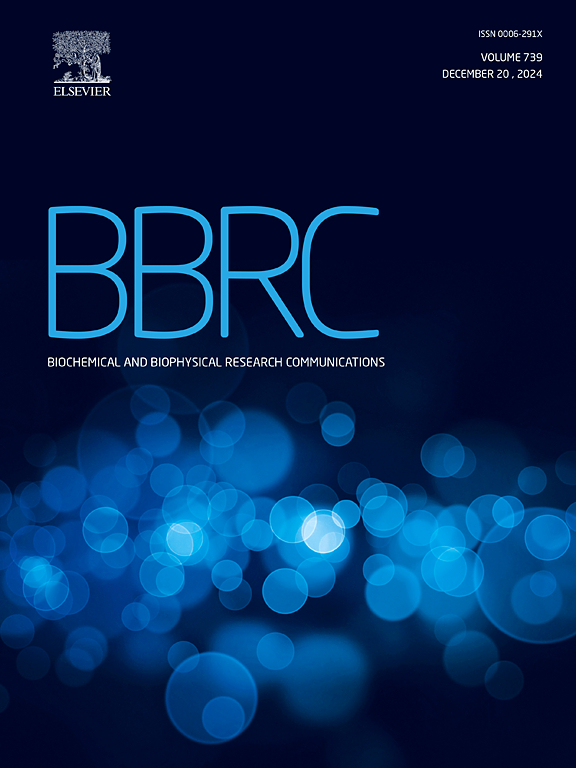扩大多鳃裸鳃亚纲 Hypselodoris tryoni 中抗疟代谢物的出现范围。
IF 2.5
3区 生物学
Q3 BIOCHEMISTRY & MOLECULAR BIOLOGY
Biochemical and biophysical research communications
Pub Date : 2024-10-30
DOI:10.1016/j.bbrc.2024.150921
引用次数: 0
摘要
本研究考察了一种呋喃四萜--呋喃蝶呤的抗疟活性,呋喃蝶呤是多疣裸鳃鱼 Hypselodoris tryoni 的主要代谢产物之一。这些裸鳃藻采集自巴厘岛水域,代谢物通过色谱法纯化。为确定代谢物的抗疟活性,进行了体内外啮齿动物疟疾疟原虫试验。研究人员还采用了硅学分子对接技术,研究了呋喃地辛与野生型伯格氏疟原虫和耐阿托伐醌伯格氏疟原虫(Y268C)之间的相互作用。该研究首次报道了呋喃地辛在对野生型伯格氏疟原虫和耐阿托伐醌伯格氏疟原虫的体内外试验中显示出良好的抗疟活性。硅学分子对接研究表明,呋喃地辛能抑制寄生虫线粒体细胞色素b(cyt b),因为它能与蛋白质Qo口袋(ef-螺旋)中的残基268相互作用。呋喃地辛与残基 268 上突变为半胱氨酸的酪氨酸结合,在 4.6 Å 的距离上与 C268 形成烷基键。本文章由计算机程序翻译,如有差异,请以英文原文为准。

Expanding the occurrence of antimalarial metabolites in dorid nudibranch Hypselodoris tryoni
This study examined the antimalarial activity of a furanosesquiterpene, furodysinin, one of the major metabolites of the dorid nudibranch Hypselodoris tryoni. The nudibranchs were collected from Balinese waters and the metabolites were purified by chromatography. Ex vivo rodent malaria Plasmodium berghei assays were conducted to determine the metabolite antimalarial activity. In silico molecular docking was employed to investigate the interaction between furodysinin against wild-type P. berghei and atovaquone-resistant P. berghei (Y268C). This study reported for the first time that the furodysinin displayed a promising antimalarial activity based on the ex vivo tests against wild-type P. berghei and atovaquone-resistant P. berghei. In silico molecular docking study showed that furodysinin inhibits the parasite mitochondrial cytochrome b (cyt b) by binding to the protein Qo pocket (ef-helix) where it interacts with residue 268, the mutation of which is known to confer resistance to atovaquone. Furodysinin binds to the mutated tyrosine at residue 268, which has changed to cysteine, forming an alkyl bond with C268 at a distance of 4.6 Å. Therefore, we predict that furodysinin has a target in Plasmodium mitochondria.
求助全文
通过发布文献求助,成功后即可免费获取论文全文。
去求助
来源期刊
CiteScore
6.10
自引率
0.00%
发文量
1400
审稿时长
14 days
期刊介绍:
Biochemical and Biophysical Research Communications is the premier international journal devoted to the very rapid dissemination of timely and significant experimental results in diverse fields of biological research. The development of the "Breakthroughs and Views" section brings the minireview format to the journal, and issues often contain collections of special interest manuscripts. BBRC is published weekly (52 issues/year).Research Areas now include: Biochemistry; biophysics; cell biology; developmental biology; immunology
; molecular biology; neurobiology; plant biology and proteomics

 求助内容:
求助内容: 应助结果提醒方式:
应助结果提醒方式:


